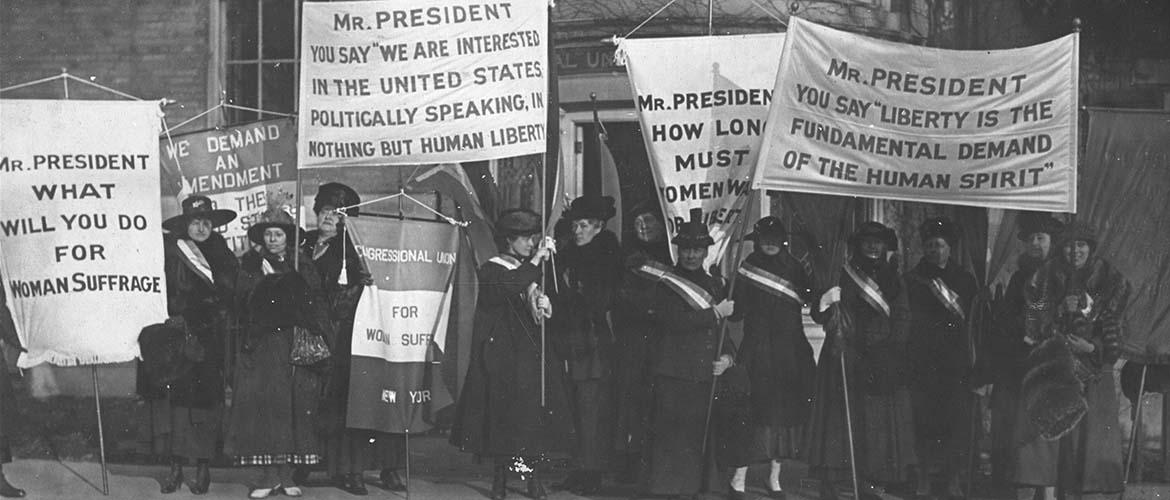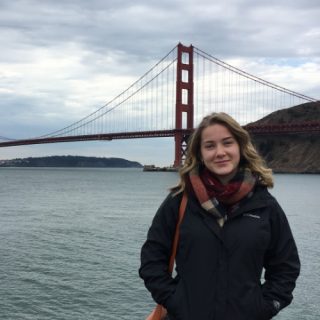
Image of women picketing during the suffrage movement, featured in Any Great Change thanks to the Library of Congress.
What does it mean to be an active citizen? Our exhibit, Any Great Change: The Centennial of the 19th Amendment, explores that question through the lens of women’s suffrage. Though the road to equal suffrage was long, it did not end with the amendment’s passage.
When Congress granted women’s suffrage in 1920, a technicality prevented Georgia women from participating in state elections until two years later. And though it didn’t deny women the vote, the Georgia legislature didn’t officially ratify the 19th amendment until 1970.
Women of color were met with even greater hurdles on the march to the ballot box. The amendment’s exact wording—”The right of citizens of the United States to vote shall not be denied or abridged by the United States or by any State on account of sex”—excluded Native American and Asian American women who had not yet been granted American citizenship. Poll taxes, literacy tests, all-white primaries, and the threat of physical violence further shut out African American women across the Jim Crow South.
When we talk about citizenship, we’re talking about active participation in shaping our community—locally and nationally. There are many ways to take part in the process, including calling your senators and volunteering at voter registration drives, or simply being informed on issues in your city and attending community events. The act of voting secures many key benefits of democracy—I want my voice to be heard, my government representatives to reflect my values, and laws that ensure my equality.
In the early 20th century, the resources, representation, and access for women living and working in Atlanta were disparate across the lines of race and class. At Swan House, the 1928 mansion at the heart of Atlanta History Center’s campus, agents of change were hard at work. Three fiercely independent, outspoken women who played key roles in the suffrage movement.
Emily MacDougald was the mother of Emily Inman, who owned Swan House.
Emily C. MacDougald and Emily Inman
The Equal Suffrage Party (ESP) of Georgia, an influential suffrage organization, was founded in the Atlanta home of the organization’s first president, Emily C. MacDougald. A determined activist and tradition-defying feminist, MacDougald managed her family’s land in Columbus, Georgia, when her husband passed away.
Later, she sold the property, moved her family to Atlanta, and became involved in social and political activism. As president of Georgia’s ESP, she coordinated the production of leaflets and organized suffrage parades. In addition to advocating for the right to vote in national elections, MacDougald and ESP fought for the right to vote in state and local elections.
MacDougald’s daughter, Emily Inman of Swan House, followed in her mother’s footsteps. She, too, was staunchly independent. When her husband passed away, Inman managed the family finances, learned how to invest in the stock market, and built a strong stock portfolio. Also a suffragist, she participated in the activities of the Equal Suffrage Party of Georgia and entered her car into Atlanta’s first Suffrage Parade in 1913.
Suffragists took to the streets to petition the right to vote wearing sashes like the one now on display at Swan House.
Elizabeth McDuffie
Another woman with ties to Swan House who campaigned for equality was the Inmans’ maid, Elizabeth McDuffie. McDuffie worked for the Inmans until 1933 when she and her husband relocated to Washington, D.C. There, she served as a maid in the White House during the Roosevelt administration. In Washington, McDuffie witnessed firsthand the pay inequalities between domestic workers throughout the district. She was an organizer of the United Government Employees workers union, which advocated for fair and adequate compensation.
McDuffie worked closely with both the president and first lady. She referred to herself as the self-appointed liaison between black America and the White House. FDR considered McDuffie to be a trusted advisor and sent her to campaign for him across the Midwest and New England in 1936 and 1940.
Though she never argued outright for women’s suffrage, she campaigned for equality nationwide. Referring to her work as “a small crusade,” Elizabeth McDuffie played a key role in the fight for equity amongst people of color.
John Lewis (second from left), the Director of the Southern Regional Council’s Voter Education Project, and staffers encouraging voter participation in Atlanta, circa 1973.
The Many Roads to Suffrage
The women’s suffrage movement was as nuanced as it was widespread. Across the United States, the movement manifested in many forms. Suffragists employed different strategies based on their geographic location and community’s goals. Activists spoke out at parades, rallies, and houses of worship, organized fundraising drives, published pamphlets and newspapers, and sowed the seeds of support.
With the growth of the suffrage movement, many of those involved in other issues came to support suffrage in order to advance their cause. Those who sought reform legislation understood that politicians rarely listened to nonvoters. For some, women’s suffrage went hand in hand with temperance, child labor laws, and other reform movements. It was believed that, if women could vote, then these “women’s issues” could pass successfully through the legislature. As a result, the suffrage movement grew in membership, ability, and authority.
The objectives of women’s groups across the country also differed. Latina women organized as labor and land-rights advocates. African American women concentrated on racial violence and access to basic educational and social equality. Their work was primarily within organizations not specifically designated for the purpose of suffrage, such as the National Association of Colored Women as well as churches and sororities. Nevertheless, the efforts of these clubs and unions advocated for women’s suffrage—the vote was understood as a means to further their advocacy work.
Racial discrimination and white supremacy affected organizations and strategies within the suffrage movement. While the birth of the women’s suffrage movement had ties to abolition, this did not mean its leaders supported universal suffrage. Many believed that black men should not have the right to vote before white women. Susan B. Anthony once stated she would rather, “cut off this right arm of mine before I will ever work for or demand the ballot for the negro and not the woman.”
In 1919, the executive committee of the Georgia Democratic Party adopted a resolution allowing women to vote in the Democratic white primary. Written by Emily MacDougald, the resolution passed 24-1. It allowed for a handful of white Atlanta women to vote in their first local election. Women of color were driven away under threat of physical violence. When black suffragists in the Jim Crow South sought help from their white counterparts, they were told that the disenfranchisement of African American women was an issue of race, not of gender, and therefore beyond the movement’s purview.
An Atlantan waits to vote in the 1973 mayoral election at her local polling place.
What’s next?
If you’re curious to learn more about the roles of McDuffie, MacDougald, Inman, and other notable women, we invite you to visit Any Great Change, located on the second floor of Swan House until it leaves on May 7, 2023. The exhibition takes a deep dive into the greater struggle for women’s rights as well as activist groups, their strategies, and their leaders. Generous funding for Any Great Change is provided by Emily Bourne Grigsby, who is committed to supporting the presentation of women’s history at Atlanta History Center.
The exhibit doesn’t stop in 1920 (or 1970!) but maps the impact of Georgia women on politics as advocates, elected officials, and organizers into the 21st century. It includes activities to get you thinking about ways to become a more active citizen.
The women of the suffrage movement fought to be engaged, active citizens even before they were granted the right to vote. Though their struggle has been won, new challenges are always on the horizon. How will you help shape the next chapter of our history?
Further Reading
- Elizabeth and Irvin McDuffie Papers | Atlanta University Center
- Lugenia Burns Hope Papers | Atlanta University Center
- Mary Wadley Raoul Papers | Emory University, Rose Manuscript, Archives, & Rare Book Library
- 100 Years of Women at Emory: May Milestones of Progress | Digital exhibition, Robert W. Woodruff Library
- The Legacy of Community Organizing: Lugenia Burns Hope and the Neighborhood Union | The Journal of Negro History
- Woman Suffrage and the 19th Amendment | National Archives, Educator Resources
- Suffrage: Women Fight for the Vote | By The People, Library of Congress transcription project
- Georgia and the 19th Amendment | National Park Service
- When the Suffrage Movement Sold Out to White Supremacy | The New York Times
- The Complex History of the Women’s Suffrage Movement | The New York Times
- Not For Ourselves Alone: The Story of Elizabeth Cady Stanton and Susan B. Anthony | PBS Digital


